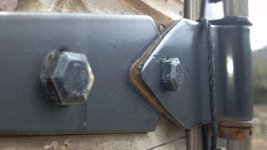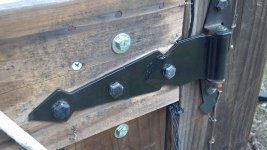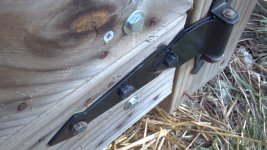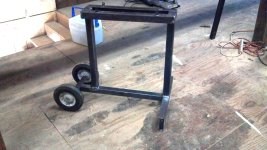My current project is a small portable welding table. I don't have permanent shelter near my 220v outlet, so I'm constantly rolling my welder into and out of the basement. I currently weld on a pair of saw horses, but that's hardly ideal. The welding table will provide both a work surface and a cart in one.
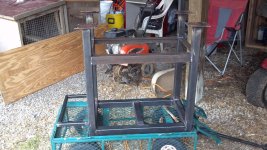
Here's the table in its current state (upside down, of course). I have learned a whole lot about keeping things square and true in this project. I got the legs within 1/4" of square while welding up the top of the table, then used a hydraulic jack to push them into final position while welding in the lower shelf support. I can't even really imagine how somebody would build something like this without the lower supports to keep the legs that last little bit of true.
Of course, after finishing welding the legs on, they were not all the same length. Well, they were all cut to the same length, but they didn't all get welded onto the top at exactly the same height, so with the top level, not all four legs were touching the ground. I worked around this by welding on the two "low" legs' plates first, then leveling the table top and sliding the "high" legs' plates underneath them, then tacking them on such that the orientation between the "high" leg and the ground was maintained. The final result is that there is about 1/16" of wobble, but I concluded that was about as good as I was likely to get and left well enough alone. I plan to take out that last bit of wobble by shimming the caster with washers.
On the bandsaw cart, I came to appreciate the weakness of 7018 and the strength of 6011 in jobs where fitup is poor. 7018 lays a pretty, pretty bead, but when there is a gap, it will blow holes in this 1/8" material no matter how careful I am, especially at the edges. As a result, I have been burning a lot more 6010, and have improved my ability to run that rod by leaps and bounds. Don't get me wrong: my 6010 beads are still so terrible that they're not really even worth critiquing, but they're much less terrible than they used to be! I have been trying to hold myself to standards and to grind out any beads that I wouldn't be willing to show my face with in public. It's very tempting to just say, "it'll hold," and move on, but I remind myself that every weld I grind out is another practice bead I get to run. In many cases, I laid down a bead that I knew was terrible just to get some metal in the gap, before grinding smooth and going back over it again.
All this grinding has been educational, as it reveals the inner structure of the weld, including any slag inclusions or porosity. I have had a few welds with no inclusions, but most of them have at least a little inclusion. Interestingly, there doesn't seem to be much correlation between how good/consistent a bead appears on the outside, and its likelihood of having an inclusion. The ones that didn't have inclusions were pretty ugly on the outside.
One lesson that I'm taking to heart is that if a bead isn't going right, it's better to just knock it off and fix what's wrong. For example, if I start the bead and feel that my wrist is going to get bound up before the end, I should stop, readjust my position, and pick up again. Working with 7018 discourages restarts, and so I had picked up the bad habit of just trying to push through to the end--to the detriment of my welds.
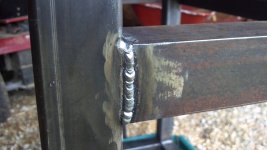
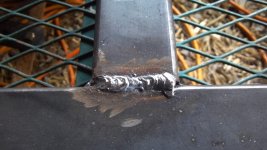
Above are a couple examples of my welds on this project. As I said, they are hardly even worth critiquing, but they are worlds better than my 6010 used to be. The main thing that I think is wrong with them is that they are cold. Either that, or my travel speed was too slow, but I suspect coldness is the issue. Unfortunately, when I ran hotter, I tended to blow through. Only by turning down the heat could I get the puddle to work slowly enough that I could manipulate it with any consistency.
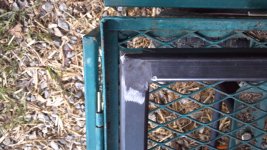
Finally, here's the weld in the project that I am most proud of. This is the handle of the cart, so I ground the weld smooth, since it would be coming into frequent contact with people's hands. When I finished, and there was no undercutting or porosity--just a smooth metal surface, as if it had always been that way--I was really thrilled.
EDIT: In case you're wondering, this is all 1/8" thick material, and I'm welding using about 60 amps with 3/32" E6011.
